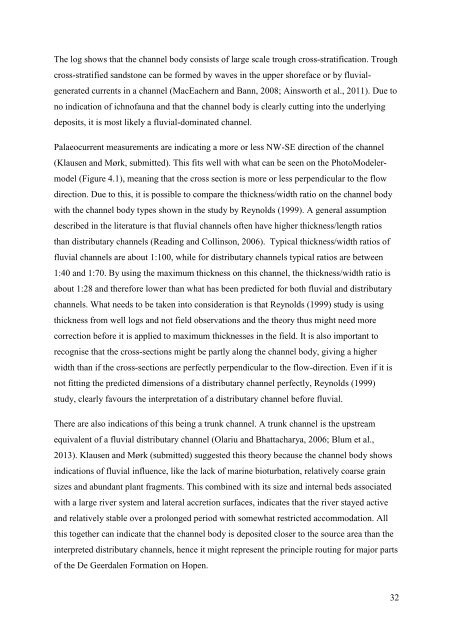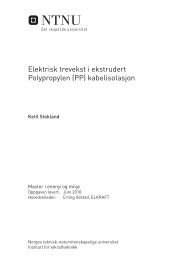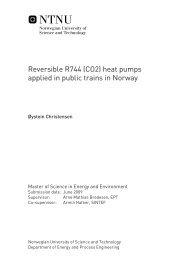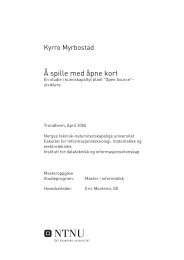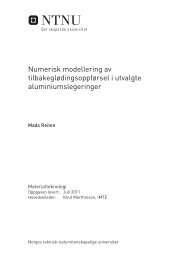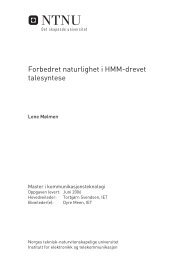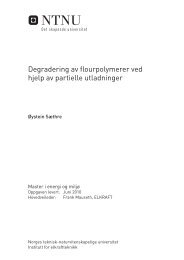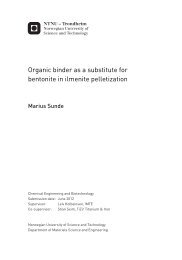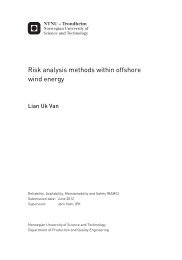Visualize and interpret the geometry, heterogeneity and lateral ...
Visualize and interpret the geometry, heterogeneity and lateral ...
Visualize and interpret the geometry, heterogeneity and lateral ...
Create successful ePaper yourself
Turn your PDF publications into a flip-book with our unique Google optimized e-Paper software.
The log shows that <strong>the</strong> channel body consists of large scale trough cross-stratification. Troughcross-stratified s<strong>and</strong>stone can be formed by waves in <strong>the</strong> upper shoreface or by fluvialgeneratedcurrents in a channel (MacEachern <strong>and</strong> Bann, 2008; Ainsworth et al., 2011). Due tono indication of ichnofauna <strong>and</strong> that <strong>the</strong> channel body is clearly cutting into <strong>the</strong> underlyingdeposits, it is most likely a fluvial-dominated channel.Palaeocurrent measurements are indicating a more or less NW-SE direction of <strong>the</strong> channel(Klausen <strong>and</strong> Mørk, submitted). This fits well with what can be seen on <strong>the</strong> PhotoModelermodel(Figure 4.1), meaning that <strong>the</strong> cross section is more or less perpendicular to <strong>the</strong> flowdirection. Due to this, it is possible to compare <strong>the</strong> thickness/width ratio on <strong>the</strong> channel bodywith <strong>the</strong> channel body types shown in <strong>the</strong> study by Reynolds (1999). A general assumptiondescribed in <strong>the</strong> literature is that fluvial channels often have higher thickness/length ratiosthan distributary channels (Reading <strong>and</strong> Collinson, 2006). Typical thickness/width ratios offluvial channels are about 1:100, while for distributary channels typical ratios are between1:40 <strong>and</strong> 1:70. By using <strong>the</strong> maximum thickness on this channel, <strong>the</strong> thickness/width ratio isabout 1:28 <strong>and</strong> <strong>the</strong>refore lower than what has been predicted for both fluvial <strong>and</strong> distributarychannels. What needs to be taken into consideration is that Reynolds (1999) study is usingthickness from well logs <strong>and</strong> not field observations <strong>and</strong> <strong>the</strong> <strong>the</strong>ory thus might need morecorrection before it is applied to maximum thicknesses in <strong>the</strong> field. It is also important torecognise that <strong>the</strong> cross-sections might be partly along <strong>the</strong> channel body, giving a higherwidth than if <strong>the</strong> cross-sections are perfectly perpendicular to <strong>the</strong> flow-direction. Even if it isnot fitting <strong>the</strong> predicted dimensions of a distributary channel perfectly, Reynolds (1999)study, clearly favours <strong>the</strong> <strong>interpret</strong>ation of a distributary channel before fluvial.There are also indications of this being a trunk channel. A trunk channel is <strong>the</strong> upstreamequivalent of a fluvial distributary channel (Olariu <strong>and</strong> Bhattacharya, 2006; Blum et al.,2013). Klausen <strong>and</strong> Mørk (submitted) suggested this <strong>the</strong>ory because <strong>the</strong> channel body showsindications of fluvial influence, like <strong>the</strong> lack of marine bioturbation, relatively coarse grainsizes <strong>and</strong> abundant plant fragments. This combined with its size <strong>and</strong> internal beds associatedwith a large river system <strong>and</strong> <strong>lateral</strong> accretion surfaces, indicates that <strong>the</strong> river stayed active<strong>and</strong> relatively stable over a prolonged period with somewhat restricted accommodation. Allthis toge<strong>the</strong>r can indicate that <strong>the</strong> channel body is deposited closer to <strong>the</strong> source area than <strong>the</strong><strong>interpret</strong>ed distributary channels, hence it might represent <strong>the</strong> principle routing for major partsof <strong>the</strong> De Geerdalen Formation on Hopen.32


